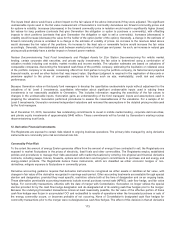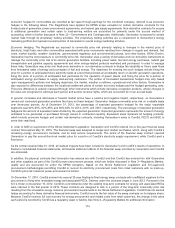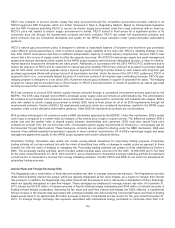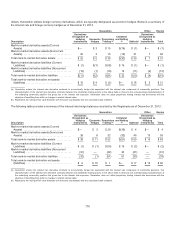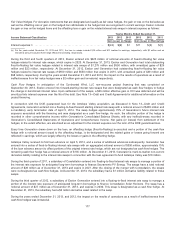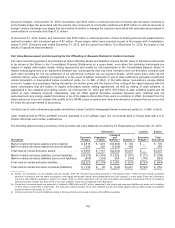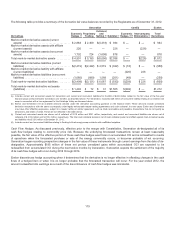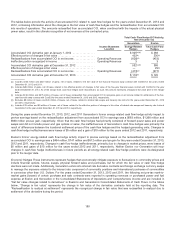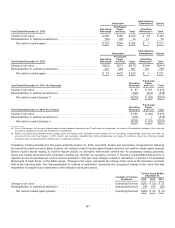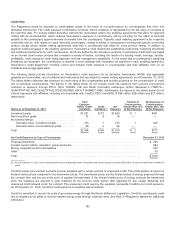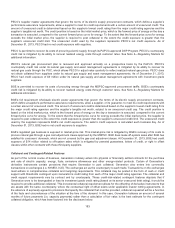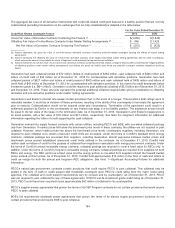ComEd 2013 Annual Report Download - page 189
Download and view the complete annual report
Please find page 189 of the 2013 ComEd annual report below. You can navigate through the pages in the report by either clicking on the pages listed below, or by using the keyword search tool below to find specific information within the annual report.PECO’s supplier master agreementsthat govern the terms ofitselectric supplyprocurement contracts, which define a supplier’s
performanceassurancerequirements, allowasupplier to meet itscreditrequirementswithacertainamount ofunsecuredcredit.The
amount ofunsecuredcreditis determinedbasedon thesupplier’s lowestcredit ratingfromthemajor credit ratingagenciesandthe
supplier’s tangible net worth. Thecreditposition is basedon theinitial market price, which is theforwardpriceofenergy on thedaya
transaction is executed, comparedto thecurrent forwardpricecurvefor energy. Totheextent that theforwardpricecurvefor energy
exceeds theinitial market price,thesupplier is requiredto postcollateral to theextent thecreditexposure is greater than the
supplier’s unsecuredcreditlimit.Theunsecuredcreditusedbythesuppliersrepresents PECO’s net creditexposure.Asof
December 31,2013, PECO hadno net creditexposure withsuppliers.
PECO is permittedto recover itscostsofprocuringelectric supplythrough itsPAPUC-approved DSP Program. PECO’s counterparty
creditrisk is mitigatedbyitsabilityto recover realizedenergy coststhrough customer rates. See Note 3—RegulatoryMattersfor
additional information.
PECO’s natural gasprocurement plan is reviewedandapprovedannuallyon a prospectivebasis by thePAPUC. PECO’s
counterpartycreditrisk under itsnatural gassupplyandasset management agreementsismitigatedbyitsabilityto recover its
natural gascoststhrough thePGC, which allows PECO to adjust ratesquarterlyto reflect realizednatural gasprices. PECO does
not obtaincollateral fromsuppliersunder itsnatural gassupplyandasset management agreements. AsofDecember 31,2013,
PECO hadcreditexposure of$9million under itsnatural gassupplyandasset management agreementswithinvestment grade
suppliers.
BGE is permittedto recover itscostsofprocuringenergy through theMDPSC-approvedprocurement tariffs. BGE’s counterparty
creditrisk is mitigatedbyitsabilityto recover realizedenergy coststhrough customer rates. See Note 3—RegulatoryMattersfor
additional information.
BGE’s full requirement wholesale electric power agreementsthat govern the terms ofitselectric supplyprocurement contracts,
which define a supplier’s performanceassurancerequirements, allowasupplier,or itsguarantor,to meet itscreditrequirementswith
acertainamount ofunsecuredcredit.Theamount ofunsecuredcreditis determinedbasedon thesupplier’s lowestcredit ratingfrom
themajor credit ratingagenciesandthesupplier’s tangible net worth, subjecttoanunsecuredcreditcap.Thecreditposition is
basedon theinitial market price, which is theforwardpriceofenergy on thedaya transaction is executed, comparedto thecurrent
forwardpricecurvefor energy. Totheextent that theforwardpricecurvefor energy exceeds theinitial market price,thesupplier is
requiredto postcollateral to theextent thecreditexposure is greater than thesupplier’s unsecuredcreditlimit.Theunsecuredcredit
usedbythesuppliersrepresents BGE’s net creditexposure.Theseller’s creditexposure is calculatedeach business day. Asof
December 31,2013, BGE hadno net creditexposure to suppliers.
BGE’s regulatedgasbusiness is exposedto market-pricerisk. This market-pricerisk is mitigated by BGE’s recoveryofitscoststo
procure natural gasthrough agascostadjustment clause approvedbytheMDPSC. BGE doesmakeoff-systemsalesafter BGE has
satisfieditscustomers’ demands, which are not coveredbythegascostadjustment clause.At December 31,2013, BGE hadcredit
exposure of$14million relatedto off-systemsales which is mitigatedbyparental guarantees, lettersofcredit,or righttooffset
clauseswithinother contractswiththosethird-partysuppliers.
Collateral and Contingent-Related Features
Aspart ofthe normal courseofbusiness, Generation routinelyentersinto physical or financiallysettledcontractsfor the purchase
andsale ofelectric capacity, energy, fuels, emissionsallowancesandother energy-relatedproducts. CertainofGeneration’s
derivativeinstrumentscontain provisionsthat require Generation to postcollateral.Generation also entersinto commodity
transactionson exchanges (i.e. NYMEX, ICE). Theexchangesactasthecounterpartyto each trade.Transactionson theexchanges
mustadhere to comprehensivecollateral andmarginingrequirements. This collateral maybepostedintheformofcash or credit
support withthresholds contingent upon Generation’s credit ratingfromeach ofthemajor credit ratingagencies. Thecollateral and
creditsupport requirementsvarybycontractandbycounterparty. Thesecredit-risk-relatedcontingent featuresstipulate that if
Generation were to bedowngradedor loseitsinvestment gradecredit rating(basedon itssenior unsecureddebt rating), itwouldbe
requiredto provideadditional collateral. This incremental collateral requirement allows for theoffsettingofderivativeinstrumentsthat
are assetswiththesamecounterparty, where thecontractual rightofoffset existsunder applicable master nettingagreements. In
theabsenceofexpresslyagreed-to provisionsthat specify thecollateral that mustbe provided, collateral requestedwill beafunction
ofthefactsandcircumstancesofthesituation at thetimeofthedemand. Inthis case,Generation believesan amount ofseveral
months offuture payments (i.e.capacitypayments) rather than a calculation offairvalue is thebestestimate for thecontingent
collateral obligation, which hasbeen factoredinto thedisclosure below.
183


